BUDAPEST — Repetitive transcranial magnetic stimulation (rTMS) can be useful treatment for some people with major depressive disorder (MDD) and obsessive-compulsive disorder (OCD), but its use is only trickling through Europe, experts said at the 32nd European Congress of Psychiatry (EPA 2024).
rTMS has been approved for use as a treatment for stubborn depression for more than a decade in the US. Although its use is relatively well established in the UK and some European countries, other European countries are still catching up, consultant psychiatrist Mohamed Abdelghani told Medscape Medical News.

"rTMS got National Institute for Health and Care Excellence (NICE) approval in December 2015 as a treatment for depression, so it should be available for most, if not all, people who suffer from treatment-resistant depression in the UK," said Abdelghani, who runs the London TMS Centre and is the immediate past president of the Clinical TMS Society.
However, "because of problems in the NHS [National Health Service], the uptake of it has been quite slow," Abdelghani observed. Today, around 20% of mental health trusts in the UK have rTMS services, he said.
Consultant psychiatrist Micheal Kurkar, who has collaborated with Abdelghani and others on the BRIGhTMIND trial, commented: "Every NHS unit in the UK should have this treatment available to patients because it's a good modality of treatment, which is effective and safe." Kurkar consults for the Pennine Care NHS Foundation Trust's TMS Service in Oldham.

He told Medscape Medical News that rTMS is noninvasive, unlike other treatments such as electroconvulsive therapy (ECT), "which is not for everyone. rTMS can be a lifeline for those in whom treatment with antidepressants has failed and who thus have treatment-resistant depression," he said.
Europe Catching Up?
Abdelghani and Kurkar were early adopters of rTMS. In 2016, Abdelghani set up and still leads the first TMS-specific clinic in the NHS in London and the second in the UK at Camden and Islington NHS Foundation Trust. Meanwhile, Kurkar was the first to set up an rTMS clinic in the Northwest of England.
Speaking after a session titled "Transcranial Magnetic Stimulation: The Miracle Weapon Against Depression and OCD?", Abdelghani and Kurkar noted that it was interesting to hear how the method was being used in other European countries.
"There are no clear European guidelines on how it should be done," said Abdelghani. "At least in the UK we've got the NICE guidelines, but practices in different parts of the world are still catching up."
In Hungary, for example, rTMS is not currently available for use in routine clinical practice, as pointed out at EPA 2024 by Dr Judit Lazáry, head of Department of Psychiatry B, National Department of Mental Health, Neurology and Neurosurgery, Budapest, Hungary.
Between 2020 and 2023, Lazáry and collaborators had European funding to run a national center for rTMS in Budapest to study the safety and efficacy of the method for both MDD and OCD. She said several studies "confirmed the safety of rTMS, [and] the patients tolerated it very well."
"Use of rTMS together with antidepressants reduces depressive symptoms, anxious symptoms, and anhedonia, while it can increase the savoring of positive experience, resilience, and also the adherence to the [antidepressant] treatment."
Lazáry and team also found that rTMS had beneficial effects for treating OCD as well as less severe forms of depression, suggesting that its use could be expanded to help more patients who needed augmentation therapy.
Dynamic Field
rTMS is just one type of neuromodulation that could be used to help people with treatment-resistant or difficult-to-treat depression, said Dr Bernhard T. Baune, professor of psychiatry and director of the Department of Psychiatry and Psychotherapy at the University of Münster, Germany, speaking at EPA 2024.
Conventional rTMS can be high or low frequency, respectively targeting the left or right dorsolateral prefrontal cortex (DLPFC), or both, to correct an alleged hypo- or hyperactivity. Then there is theta-burst stimulation, used intermittently on the left DLPFC or continuously on the right DLPFC, and there are accelerated protocols in which more than one treatment session is given daily.
"Where we need a combination of treatments, TMS can be very nicely combined with pharmacological treatment. We also have experience in our university hospital of combining TMS with psychotherapy, but also other treatment modalities such as VNS [vagus nerve stimulation] and also ketamine, and ECT as well," Baune said.
"The field, I think, remains quite dynamic," added Baune. "We are now in a very prosperous phase where the combination of these treatments is quite promising."
Abdelghani commented on the cost of setting up a TMS service, pointing out that treating people who have difficult-to-treat depression is already very costly for the healthcare system.
"Some people from the outset might think that TMS is expensive. But actually, according to the BRIGhTMIND trial, there is a strong suggestion that it saves money. So, it's as if you're investing in the future."
Results of the cost-effectiveness and other secondary analyses from the BRIGhTMIND trial are expected to be published soon.
No relevant financial relationships or funding were reported by the experts quoted in this article.
Sara Freeman is a freelance medical journalist based in London, England.

